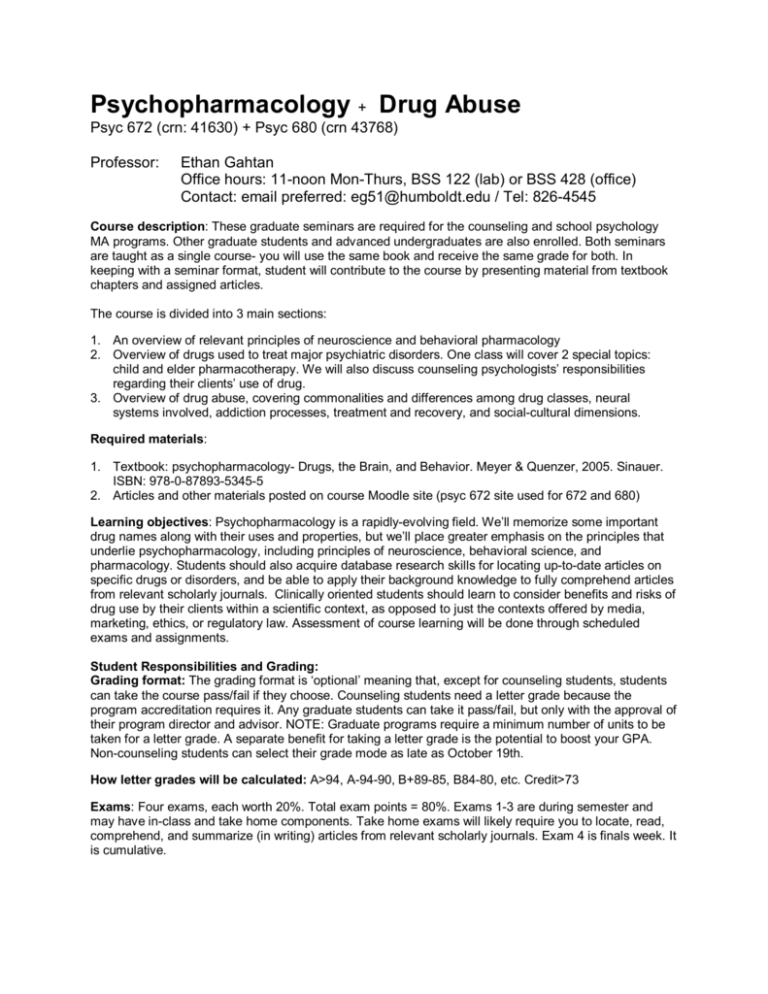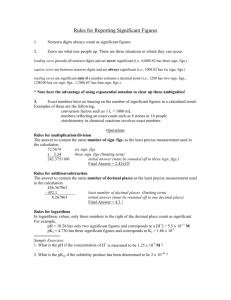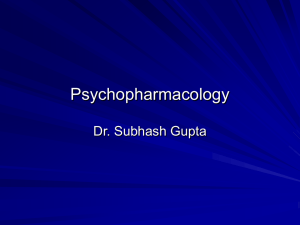Psychopharmacology + Drug Abuse
advertisement

Psychopharmacology + Drug Abuse Psyc 672 (crn: 41630) + Psyc 680 (crn 43768) Professor: Ethan Gahtan Office hours: 11-noon Mon-Thurs, BSS 122 (lab) or BSS 428 (office) Contact: email preferred: eg51@humboldt.edu / Tel: 826-4545 Course description: These graduate seminars are required for the counseling and school psychology MA programs. Other graduate students and advanced undergraduates are also enrolled. Both seminars are taught as a single course- you will use the same book and receive the same grade for both. In keeping with a seminar format, student will contribute to the course by presenting material from textbook chapters and assigned articles. The course is divided into 3 main sections: 1. An overview of relevant principles of neuroscience and behavioral pharmacology 2. Overview of drugs used to treat major psychiatric disorders. One class will cover 2 special topics: child and elder pharmacotherapy. We will also discuss counseling psychologists’ responsibilities regarding their clients’ use of drug. 3. Overview of drug abuse, covering commonalities and differences among drug classes, neural systems involved, addiction processes, treatment and recovery, and social-cultural dimensions. Required materials: 1. Textbook: psychopharmacology- Drugs, the Brain, and Behavior. Meyer & Quenzer, 2005. Sinauer. ISBN: 978-0-87893-5345-5 2. Articles and other materials posted on course Moodle site (psyc 672 site used for 672 and 680) Learning objectives: Psychopharmacology is a rapidly-evolving field. We’ll memorize some important drug names along with their uses and properties, but we’ll place greater emphasis on the principles that underlie psychopharmacology, including principles of neuroscience, behavioral science, and pharmacology. Students should also acquire database research skills for locating up-to-date articles on specific drugs or disorders, and be able to apply their background knowledge to fully comprehend articles from relevant scholarly journals. Clinically oriented students should learn to consider benefits and risks of drug use by their clients within a scientific context, as opposed to just the contexts offered by media, marketing, ethics, or regulatory law. Assessment of course learning will be done through scheduled exams and assignments. Student Responsibilities and Grading: Grading format: The grading format is ‘optional’ meaning that, except for counseling students, students can take the course pass/fail if they choose. Counseling students need a letter grade because the program accreditation requires it. Any graduate students can take it pass/fail, but only with the approval of their program director and advisor. NOTE: Graduate programs require a minimum number of units to be taken for a letter grade. A separate benefit for taking a letter grade is the potential to boost your GPA. Non-counseling students can select their grade mode as late as October 19th. How letter grades will be calculated: A>94, A-94-90, B+89-85, B84-80, etc. Credit>73 Exams: Four exams, each worth 20%. Total exam points = 80%. Exams 1-3 are during semester and may have in-class and take home components. Take home exams will likely require you to locate, read, comprehend, and summarize (in writing) articles from relevant scholarly journals. Exam 4 is finals week. It is cumulative. Assignments: Two assignments, each worth 10%. Assignments total = 20%. NOTE: ‘catch-up’ days built in to the syllabus mean your assigned presentation date may be delayed 1 class. Assignment 1: Reading discussion leader (“R” on reading calendar). Work independently. You are assigned a chapter of the text book that all students will also read. You have one written and one in-class component to your assignment on the chapter. Written component: the reading calendar specifies a few figures from each text chapter. You will moodle upload original questions based on the figures and associated information in the text. Question format is open- try for what you think would be a good exam or discussion question, i.e., important, relevant, and fair. Upload questions anytime before class meeting, and be prepared to pose them in class. In-class component: be prepared to explain any figure from the chapter when it’s projected in class. Grading will be based on punctual uploads and strength of questions. There are 2-3 students assigned to each text reading- each does the assignment independently. Assignment 2: In class presentations. Work independently or in pairs. You will be assigned a journal article, journal TOC, or other reading (“A” on reading calendar), and will deliver a 5 slide, 15 min powerpoint presentation on it. Only presenters are required to read it, but everyone can and should. Suggested slide organization: SLIDE 1. Introduce yourself, the title, and bibliographic info of your reading, SLIDE 2. For articles, an abstract laying out essential background (general field, methods, goals, expected and actual results). For journal TOC, mission statement, scope, intended readers, affiliations, etc- fully explore the journal website. SLIDES 3-4. For articles, present the key figures from the papers and explain them in detail. If there are no figures, you may draw figures (computer or white board), use text, or use any other visual aids. For journal TOC, present the full text of the TOC (current or previous) and highlight 4 articles (or editorials, book reviews, etc) of most interest to you. Read the full abstract or full text for all of them (use only titles for which abstracts at least are obtainable). Read the titles to the class and explain them in sufficient detail (based on your understanding after reading abstracts or articles) so that the goals and conclusions are clear. Use visual aids. SLIDE 5. Take home message. For articles, this should take the form of what your article found and why it was important to the field of psychopharmacology. For journal TOC, state how your 4 pieces fit the journal mission, and how that mission fits within the field of psychopharmacology and our course. Grading is based on organization, clarity, and depth of knowledge displayed. Late or missed exams and assignments: Maximum 50% credit for late exams or assignments. Attendance policy: Allowed 2 unexcused absences. For each additional, minus half letter grade. Class participation: Can help your grade. Services available for students with disabilities. Persons who wish to request disability-related accommodations should contact the Student Disability Resource Center in House 71, 826-4678 (voice) or 826-5392 (TDD). Some accommodations may take up to several weeks to arrange. http://www.humboldt.edu/~sdrc/ Add/Drop policy: Students are responsible for knowing the University policy, procedures, and schedule for dropping or adding classes. http://www.humboldt.edu/~reg/regulations/schedadjust.html Emergency Evacuation Plan - plan for classroom BSS 204 (posted on the orange signs) , and review http://studentaffairs.humboldt.edu/emergencyops/campus_emergency_preparedness.php for information on campus Emergency Procedures. During an emergency, information can be found campus conditions at: 826-INFO or www.humboldt.edu/emergency Academic honesty: Students are responsible for knowing policy regarding academic honesty: http://studentaffairs.humboldt.edu/judicial/academic_honesty.php or http://www.humboldt.edu/~humboldt/catalogpdfs/catalog2007-08.pdf Course Calendar 1 8/25 2 9/1 3 9/8 4 9/15 5 9/22 6 9/29 7 10/6 SECTION 1 - PRINCIPLES OF NEUROSCIENCE AND PSYCHOPHARMACOLOGY -- Theme of articles is Neural Systems --- Movie Night 1. (optional): “Young Frankenstein” Friday 8/28, 8PM BSS 204 --- Movie Night 2. (optional): “Awakenings” Friday 9/18, 8PM, BSS 204 -Neuroscience basics Ch 2,3 Pharmacology basics Ch 1,4 R1. Ch1. Figs. 1.1, 1.3, 1.5, 1.7, Table 1.5, 1.9, 1.10, 1.15, 1.16 R2. Ch4. Figs. 4.3-4, 4.7, 4.11, 4.9, 4.14, 4.18, Box 4.1 A1. TOC: Psychopharmacology (Journal 3) A2. Neurosymphony of stress Begin Ch 5,6Neurotransmitters R3. Ch5. Figs. 5.2, 5.3, 5.4, 5.5, 5.7, 5.9, 5.11, 5.14, Box 5.2B R4. Ch6 Figs. Box 6.1, 6.2, 6.4, 6.7, 6.14, 6.16, 6.17, 6.19 A3. Pleasure-pain neural systems A4. TOC: J. Clin Psychopharm (journal 2) Finish Ch 6,7 Neurotransmitters R5. Ch7. Figs. 7.2, 7.3, 7.4 (NMDA diff), 7.6, 7.7, Box 7.1B, 7.14 A5. Oxytocin and trust Nature 2005 A6. Behavioral dopamine signals NOTE: Michael Jackson’s death linked to Propofol Section synthesis & Take home exam 1 due 6/25 via moodle upload catch-up SECTION 2- PSYCHIATRIC DISORDERS- NEURAL BASES AND PHARMACOTHERAPIES -- Movie Night 3 (optional): “One Flew Over the Cuckoo’s Nest” Friday 10/2, 8PM, BSS 204 -Begin Psychiatric Ch 16,17Disorders R6. Ch16. Figs.16.1, 16.2, 16.7, 16.9, 16.14, 16.16 -Affective & Anxiety R7 Ch17. Figs. 17.9, 17.14, 17.15, 17.18, 17.20 disorders A7. TOC: Pharmacology, Biochemistry and Behavior (journal 6) A8. Depression neurobiology Finish Psychiatric Ch 17,18 Disorders R8 Ch18. Figs. Box 18.1, 18.3, 18.6, 18.8, 18.9, 18.15 Anxiety disorders & A9. D-cycloserine Schizophrenia A10. Neuroimaging for drug discovery for schiz 8 10/13 Special Focus: Child and Geriatric psychopharmacology 9 10/20 Section synthesis & catch-up A counselor’s role with medicated patients A11. Biederman pediatric bipolar editorial 2003 A11.4 Biederman Resperidone child ADHD Janssen See also ‘availability’ at http://en.wikipedia.org/wiki/Risperidone A11.5. Harvard child bipolar scandal (read moodle external links) A12. TOC: J Child Adolescent Psychopharm (journal 11) A12.5 Geriatric Psychopharmacology Take home exam 2 due 10/16 via moodle upload Guest lecture by Dr. Dupree SECTION 3- RECREATIONAL DRUG USE, DRUG ABUSE, AND ADDICTION -- Movie Night 4 (optional): “Drug Store Cowboy” Friday 10/30, 8PM, BSS 204 -10 10/27 Drug Abuse Ch8 R9. Ch8. Figs. 8.9, Box8.2A-D, 8.18 A13. TOC: NIDA Addiction Science (journal 8) A 14. Neurobiol_Addiction_NRN_2004. 11 11/3 Alcohol and Optiates Ch 9,10. R11. Ch 9. Figs. 9.5, 9.12, 9.13, 9.15-17, 9.20 R12. Ch10. Figs.10.8, 10.9, 10.10, Table 10.1, 10.11, 10.14 A15. TOC: Alcohol (journal 9) A16. Counselor attitudes on alcohol pharmacotherapy 12 11/10 Cocaine, Amphetamines Ch 11,12 Nicotine, Caffeine R13. Ch 11. Figs.11.6, 11.7, 11.9, 11.11, 11.12, 11.17, 11.18 R14 Ch 12. Figs.12.7, 12.9, 12.13, 12.17-19 A17. DA transients during rat sex (point is reward ‘transience’) A18. Nicotine dependence pharmacology and treatment 13 11/17 Cannabinoids Ch 13,14 Hallucinogens, PCP, Ketamine R15 Ch13. Figs. 13.7, 13.9, 13.10, 13.13, 13.14, 13.16-18 R16. Ch14. Figs. 14.2, 14.5, 14.7, 14.12 A19. Cannabis_Nature_Neuro_Reviews A20. Serotonin-glutamate receptor complex in LSD and psychosis 14 12/1 Section synthesis & catch-up Take home exam 3 due 12/4 via moodle upload 15 12/8 Review for final. A21. Drug promotion, politics, economics, and society Discuss: Influence of drug marketing on health, disease, society. Journals 1. 2. 3. 4. 5. Experimental and Clinical Psychopharmacology (APA) http://www.apa.org/journals/pha/homepage.html Journal of Clinical Psychopharm http://journals.lww.com/psychopharmacology/pages/default.aspx Psychopharmacology http://www.springerlink.com/content/0033-3158 Journal of Psychopharmacology http://journals.lww.com/psychopharmacology/pages/default.aspx Human Psychopharmacology: Clinical and Experimental http://www3.interscience.wiley.com/journal/4216/home 6. Pharmacology, biochemistry and Behavior http://www.elsevier.com/wps/find/journaldescription.cws_home/525485/description#description 7. Neuropsychopharmacology (Am College Neuropsychopharm) http://www.nature.com/npp/index.html 8. Addiction Science and Clinical Practice (NIDA) http://www.drugabuse.gov/ascp/vol5no1.html 9. Alcohol: http://www.elsevier.com/wps/find/journaldescription.cws_home/525453/description#description 10. Drug and Alcohol Dependence http://www.sciencedirect.com/science/journal/03768716 11. J Child Adolescent Psychopharm http://www.liebertpub.com/products/product.aspx?pid=29 Other links 1. 2. APA division of Psychopharmacology and Substance Abuse http://www.apa.org/divisions/div28/brochure.html National Institutes on Drug Abuse (NIDA) http://www.nida.nih.gov/






